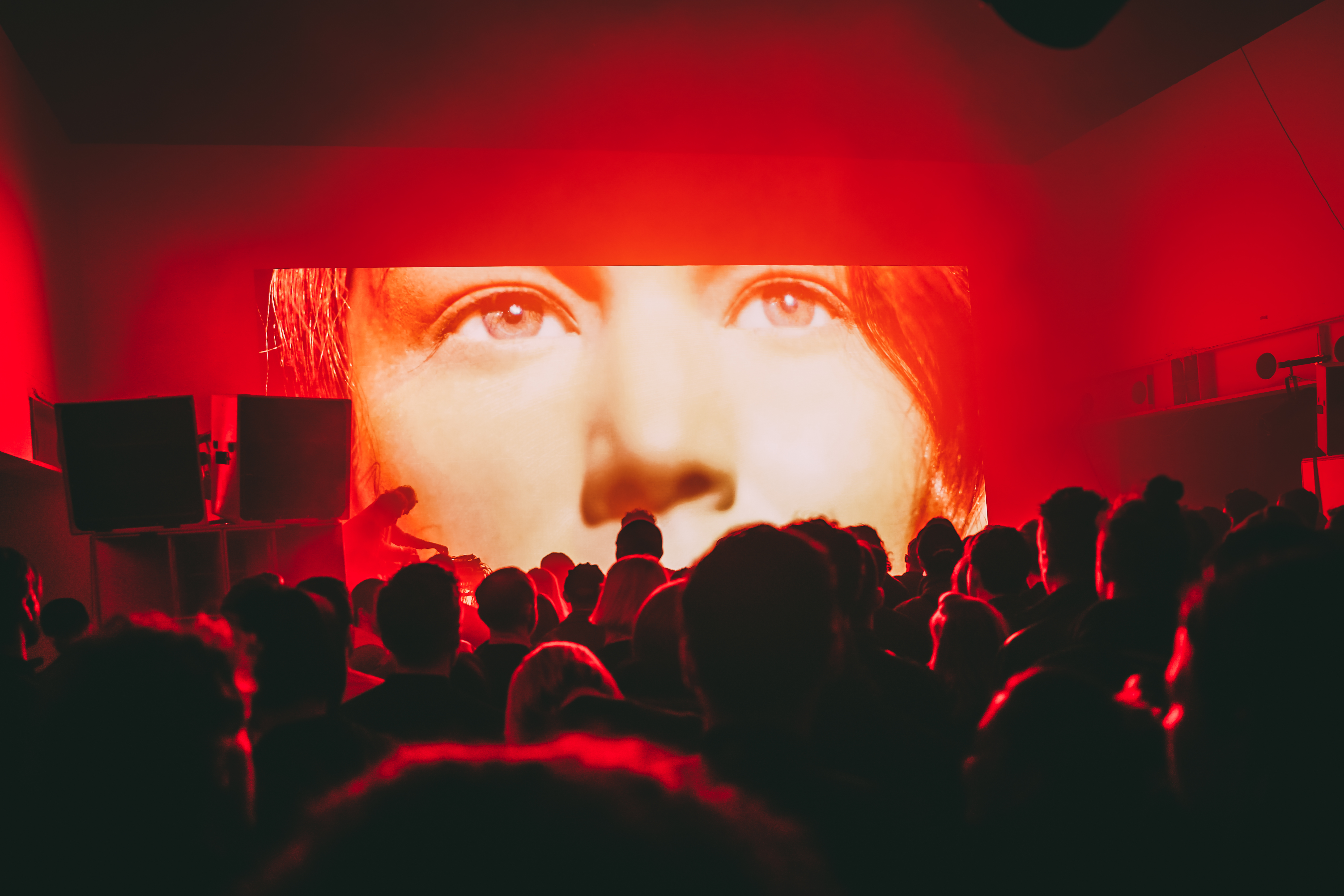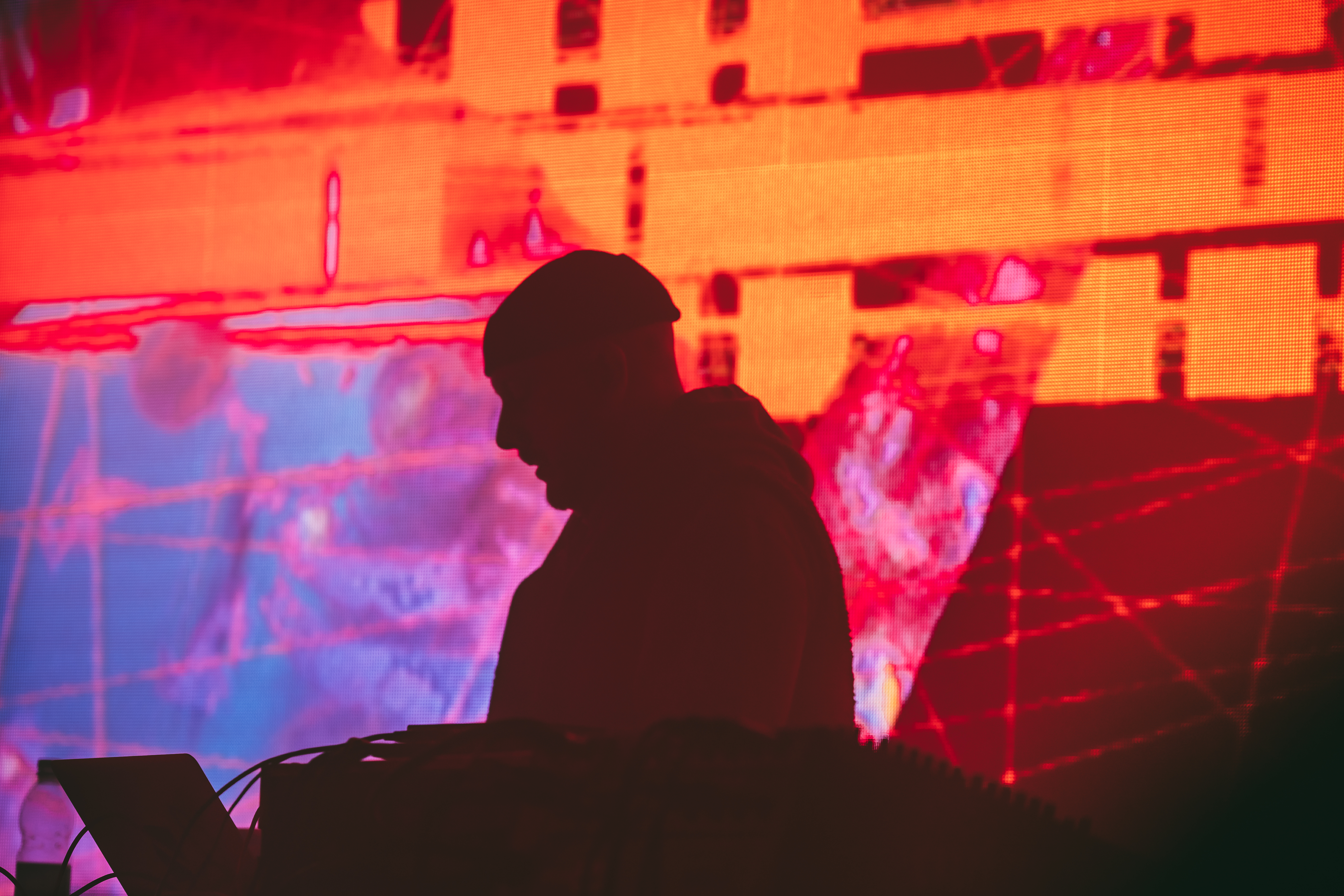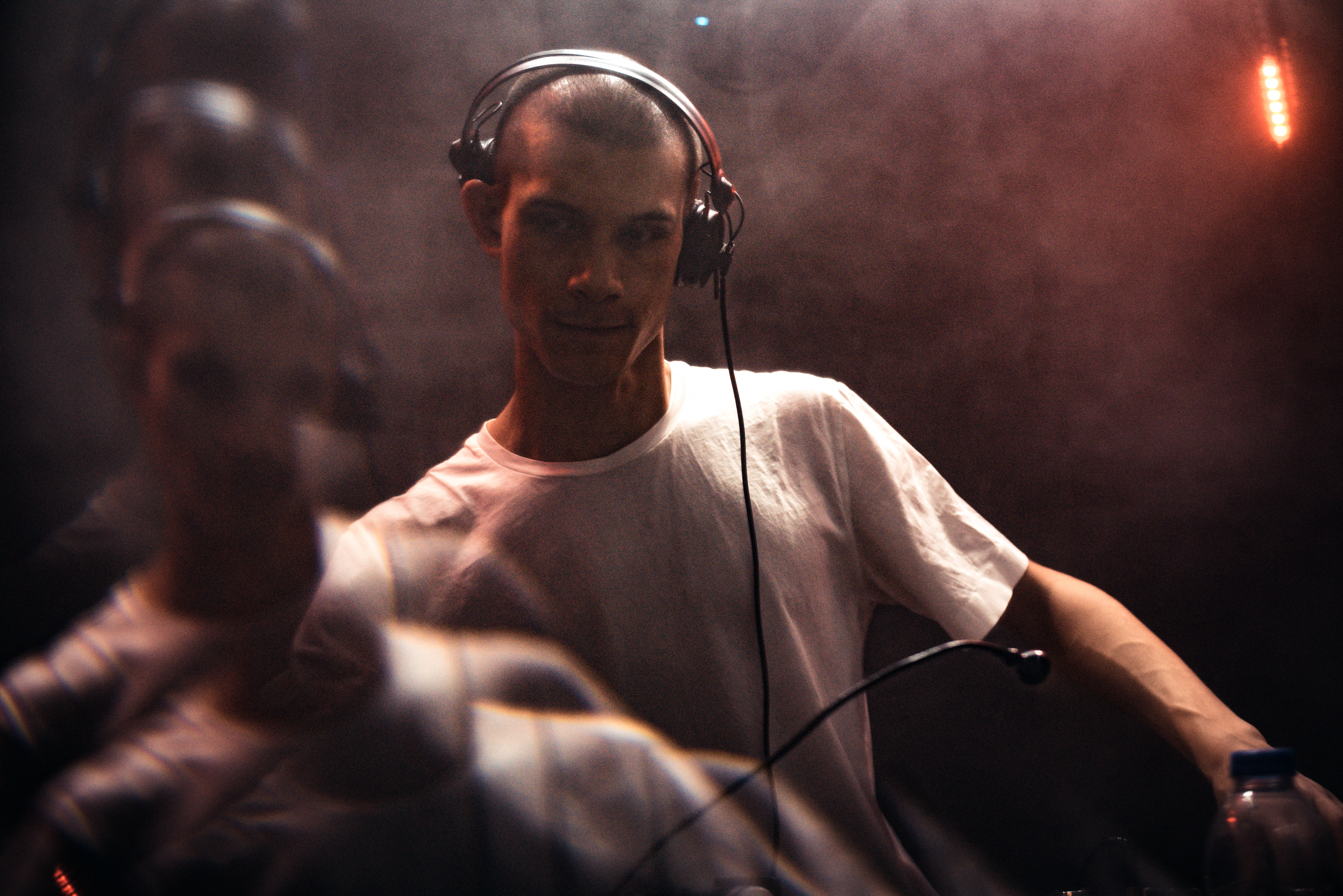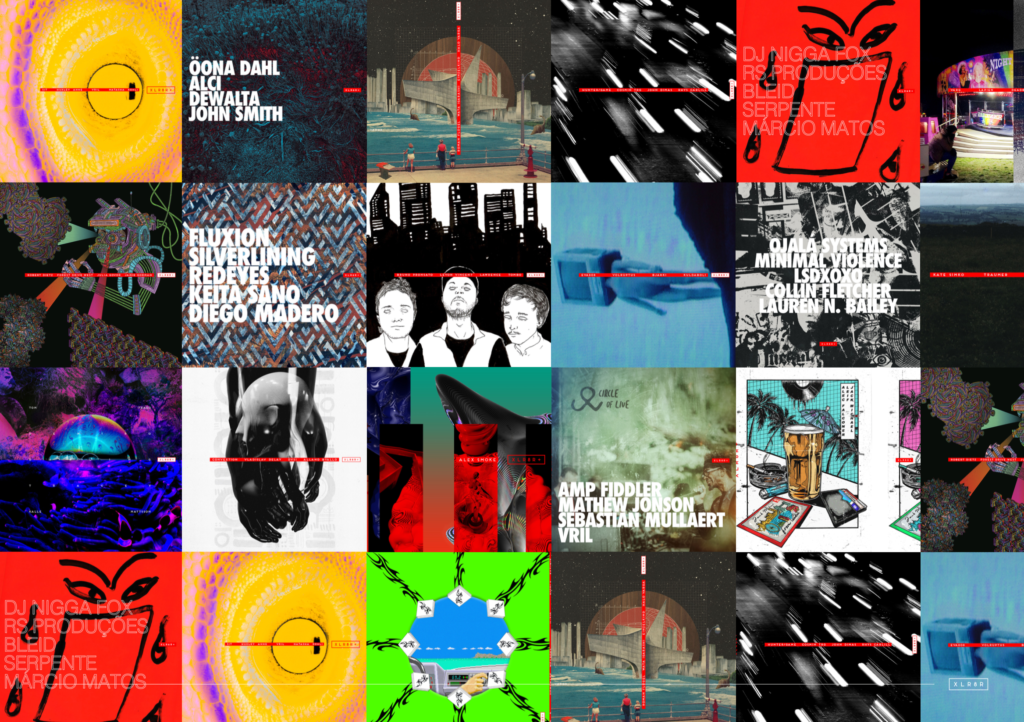Review: Re-Textured Festival 2019
A successful first event that raises some important questions.

Maybe it’s because I’m a Londoner, but I’ve always seen festivals as a holiday, a chance to get away from the city. Festivals in the capital are often a letdown, hampered by poor sound, dodgy crowds, and the simple fact that if it’s happening in a park with towering stages blocking out the sky, it could just about be anywhere. Retextured Festival, which hosted its inaugural event last weekend, promised to make use of London like no other festival has done before.
Taking place over four consecutive nights beginning on Thursday, March 28, Retextured occupied a total of six venues around London. Its lineup—apart from being one of the best at any event this year—leaned towards the experimental, dark, and serious side of techno, curated by brothers Danny and Kieran Clancy, who DJ together as Krankbrother. Its final USP was an aesthetic theme of brutalism, which paired the deep—often brutal—sounds of its performing artists with some of London’s greyest architecture.
It was a formidable setup, but not without its challenges. London’s festival scene is far from perfect, its nightlife has long been infamously troubled. This is down to a number of factors: I for one often think I’d enjoy nights out in London much more if it wasn’t for all the Londoners. Then there’s the cost: for punters, who spend a week’s wages on travel, tickets, and drinks; and promoters, who spend thousands hosting a single night, and millions on an event as big as Retextured.
“…without also promoting smaller, genuinely underground niches—scenes like garage and dubstep in the past, or drill and hard drum today—such scenes will never flourish.”
That also calls into question the legacy this festival is likely to leave once it’s over. The impact of booking venues like the Southbank Centre and acts like Nina Kraviz is that any other promoter must spend similar amounts to compete, creating a landscape where only those with huge financial backing can host events. It’s a trend of consolidation, whereby the economy shrinks to a select few organizations, that’s been prevalent in London for some time, and it also extends to the artists being booked to play. As juicy as Retextured’s lineup may be, it featured many of the same artists who have been on rotation in the capital—and the global club circuit—for years; it’s no surprise that London should attract the relative superstars of the scene, but without also promoting smaller, genuinely underground niches—scenes like garage and dubstep in the past, or drill and hard drum today—such scenes will never flourish.


Anyway, as I made my way to 180 The Strand on Thursday evening I was troubled by a rather more mundane question: would I be sitting down or standing up? My choice of entertainment meant I missed Trevor Jackson and Cabaret Voltaire at Village Underground but I was seeing artists—Puce Mary, Lee Gamble, and Demdike Stare—who occupied that space between dance music and experimental art, halfway between music to observe and music to participate in. As it turned out, I (and everyone else) was standing, which disappointed me a little: most of the crowd were stock-still, arms folded or hands on hips throughout the four hours of music, save for a few defiant head-bobbers moving to every sporadic beat.
There was little semblance of rhythm during Puce Mary’s set however, 45 minutes of relentless noise interspersed with the artist’s opaque, incomprehensible singing. Noise—the genre—is built on overwhelming the listener with dense atmospheres and dizzy crescendos, but the Danish experimentalist’s set was more like one constant, self-perpetuating crescendo devoid of breathing room or any obvious narrative. When it came, her actual climax was met with a cheer, presumably of relief.
10 minutes later and the revving of a car engine announced Lee Gamble’s arrival. Since 2017’s Mnestic Pressure, the Brum composer’s deconstructionist gaze has turned from rave to automobiles, as heard on this year’s In A Paraventral Scale. That mini-album accounted for all the recognizable moments here (as well as some previously unheard but thematically similar stuff, presumably from the subsequent records in the vaunted trilogy.) Sounds ranged from rampant gabba rhythms to burbling exhaust pipes, and its modest 35 minutes sped past; the crowd responded positively, forever on their toes, though unable to find a steady beat.
Gamble was good but the night’s highlight was the audiovisual spectacle of Demdike Stare, the best of the weekend’s several A/V live sets. Usual Demdike collaborator Michael England could be seen crouching alongside the band members at a table perpendicular to the screen, three forty-somethings fiddling with untold machines as a montage of expressive dancers, tourists, wax celebrities, and Matrix code unfolded beside them. It was stunning all round. Wouldn’t have minded a seat though.

Friday’s action didn’t start until 10 p.m. and was basically a straight shootout between four venues. Village Underground offered Deena Abdelwahed, Machine Woman, and Giant Swan; E1 had Karen Gwyer, Objekt, Lena Willikens, Aurora Halal, and Dr Rubinstein; the magnificent Walthamstow Assembly Hall (more on that in a minute) hosted four hours of Nina Kraviz; and Aïsha Devi and Fatima Al Qadiri played the Southbank Centre. While I would have liked to take in all four, without a time machine one was the limit, and I plumped for E1.
The first few hours saw an excellent warmup from Krankbrother and an electroid live set from Karen Gwyer, but the night’s dominant narrative was the hour-long clash between Dr Rubinstein and Objekt. Clubbers enter E1’s main room onto a long dancefloor with the DJ at the opposite end; by the time Objekt took the stage at 3am that space was largely empty, Rubinstein having sucked most of the club’s attendees into Room 2 during her opening hour. The Israeli spinner unleashed an onslaught of thunderous techno— including Voiron’s acidic “Generation Voiron”—which was difficult to leave. I tore myself away intermittently, but found an increasingly depleted crowd largely nonplussed by Objekt’s selections. That said, his last 10 minutes were sublime: Galaxy 2 Galaxy’s “Journey of the Dragons” into Oneohtrix Point Never’s “Hyperdawn,” a heavenly closer which Lena Willikens seemed to momentarily consider mixing out of before thinking better of it. Her subsequent two hours of extremely weird techno closed the night beautifully as DJ Nobu thrashed apart Room 2.
Before then I had briefly ventured into E1’s chillout room—finally a chance to sit down! Well, sort of: there were no bean bags, no sofas, not even a cushion; instead, for some reason, there were a handful of wooden blocks, each with about five people perched awkwardly on them and even more sitting cross-legged on the floor below. I’m hesitant to criticise as The Return of the Chill™ is long overdue, especially in London’s clubs, but E1’s effort is only half the job. Those lovely whale sounds and chemical projections are useless if they’re drowned out by the muffled thud of the adjoining Room 2, not to mention the agitated murmurs of uncomfortable punters.

That sense of almost-comfort served as the weekend’s biggest reminder that I was, in fact, still in London. After front-crawling E1’s heaving smoking area, I found myself confronted by an actual man wearing Hollister (like ohmigod) who was strangely keen to tell me who his dad was. Inside the club, a sign announced Free Water at the Central Bar on erm, a central bar, but after asking a barman I discovered that actually, this bar wasn’t the Central Bar and that they had more important matters to attend to anyway. All weekend the staff were at best disconnected and at worst standoffish: “this is a pile of shit ain’t it?!” a bouncer had replied after I’d inquired about the toilet during Puce Mary’s set. I’d laughed, much like I did after hearing that the E1 cloakroom cost three quid.
This was London whether you liked it or not—and few other cities could have hosted the wealth of talent available on the Saturday. Some daytime music would have been nice, but the earliest sets began at 7 p.m., from which point onwards the aforementioned venues—plus East London’s Silver Building—hosted sets from Volvox, Blawan, Surgeon, Lucrecia Dalt, Jan Jelinek, Object Blue, Anastasia Kristensen, Phase Fatale, and Sync 24, among several others. I missed all that though, opting instead for Walthamstow Assembly Hall and—first—The Orb.
Alex Paterson’s merry men were billed to play the Southbank Centre’s Queen Elizabeth Hall for 90 minutes from 8 p.m. but set times mean about as much to The Orb as the concept of time itself. I entered at around 7:45 to find their set already underway, a psychedelic dub thrum that oozed around the hall, seeming to cancel out the usual laws of perception, judgement, and gravity. Band members floated between the stage and the crowd as memories of Pink Floyd, the Beach Boys, and “Fluffy Clouds” drifted through the speakers, all while a Dadaist rainbow road of visuals unspooled onscreen. This was a seated event, but by the end the only punter sitting down was a man apparently having an out-of-body experience who looked like Tom Hanks at the end of Castaway. Everyone else was down the front engaged in a spiral-eyed jig. It was like being inside the mind of Super Hans from Peep Show, a choreographed orgy of ambient reggae, comedy, and LSD.
Several eternities later, The Orb finished to a standing ovation, and it was just past 10 p.m. I’d missed JASSS’s Steam A/V set— another mind-bender, I later heard—and had to hurry to catch Alva Noto. There aren’t many festivals where the trip between stages requires a 60-minute tube ride (another reminder of London’s unique charm), but the location was almost a headliner in itself, an art deco rave haven overlooking Walthamstow’s impressive Town Hall fountain. The room resembles a posh school hall, with wooden flooring, imposing red curtains, and a stage at the far end. On the night this was adorned with a huge LED screen, upon which Alva Noto’s electrified UNIEQAV visuals played out like a glitching EKG heart monitor. The German’s set phased brilliantly between tense builds and cacophonous energy surges, each signposted by a bass eruption that could have been an exploding bomb.
The burgeoning crowd was twisting and body-popping to every Noto kick, but was left scratching its collective head once his hour was over, at which point the music stopped for at least 20 minutes. Surely a festival of this size and ambition could have found a DJ to fill the gaps between slots?
But up or down, dancers were entranced by what came next (after another period of agonizing silence mind you). As I mopped my forehead and wished I’d worn shorts, out strolled Moritz von Oswald in suit trousers, shirt, sweater, and blazer, complete with pocket square. Without breaking sweat, without moving his head, without even raising an eyebrow, the Basic Channel co-founder orchestrated two hours of dubby technoid bliss. Simply tapping at a laptop with one hand, he played nothing I recognized, guiding the room from dark bass undulations up into celestial trance frequencies, all of it enveloped in dubwise negative space.

I spent most of the night on my feet and left on a high, but paid for it on Sunday. Even by 6 p.m.—when I reached the Silver Building for Caterina Barbieri, Shackleton, and Silvia Kastel—I had a headache, and wasn’t the only one. The venue’s two small rooms made for challenging acoustics, with every bass note below a certain pitch replaced by the rattling of a speaker and anything above its upper limits emitting an earsplitting screech that had several punters covering their ears. After last night’s up, I could have down with some down, but was once again forced to stand—as was everyone else, meaning only those in the front few rows actually saw the visual component of Barbieri’s A/V set, while the rest of us could make out no more than what looked like the tops of mountains onscreen. The music was terrific, synth sorcery and some of the Italian’s own angelic voice, taken mostly from her upcoming album, Ecstatic Computation. It felt somehow suffocated though; her dirge-like compositions are best suited to churches and cathedrals, not dingy classrooms. Chatting to me afterwards, Barbieri agreed: she had been sold the event on its brutalist architecture and was dismayed to find a space way smaller than it looked in photos.
The problem persisted during Shackleton’s excellent bass set, though most of the crowd were happy enough to groove away to his rhythmic syncopations. Kastel played for four hours in the even smaller Room 2, making the most of a capacity no bigger than about 20 with a gurgling set of experimental and glitch. Silvertown, the Thameside district in which the Silver Building is located, is dominated by factories and the smell of pollution, making it a logical choice for Retextured’s concrete celebrations. But these rooms weren’t big enough, no matter what they look like from the outside.

That meant Sunday’s artists, some of the more left-field on the bill, were wasted. And while the bill was as good as any London-based experimental event in recent memory, there was no algorave, no drone, no footwork, no kuduro, no hard drum, no nu-jazz, no deconstructed trance, no future speed garage—it seems silly to complain about what wasn’t there, but compared with, say, Unsound’s lineup last year, Retextured looks a bit safe.
“Retextured has undoubtedly made a lot of money for a number of big acts, many of whom will now return to Berlin or New York; meanwhile the artists of London’s overlooked mini-genres struggle on.”
And what of London’s many microscenes now? All the aforementioned sub-genres have bubbling communities in the capital, but they need income to survive. To make another comparison: Nuits Sonores, a city festival based in several venues around Lyon, prides itself on its promotion of local talent (lesser known Lyon acts like Abschaum, Blackthread, and The Horsebites are on this year’s bill), meaning the surrounding community benefits from the event as well as those organizing it. By contrast, from a total of 47 artists named on Retextured’s bill, I count just six from London—including Krankbrother. This model of events hosting is closer to that of FIFA, attracting the world’s biggest names for a concentrated period of profit before leaving ruptured local communities in their wake. Retextured has undoubtedly made a lot of money for a number of big acts, many of whom will now return to Berlin or New York; meanwhile, the artists of London’s overlooked mini-genres struggle on.
Considering this year’s turnout, it’s likely that Retextured will return to London before long. The future could see its schedule expand to include daytime entertainment, making it hard to see another London festival matching it for big-name electronic and experimental artists. This year, despite a mixed selection of venues and a city that can’t decide if it’s up or down, was successful. Its ensuing legacy will determine what that means for electronic music.

